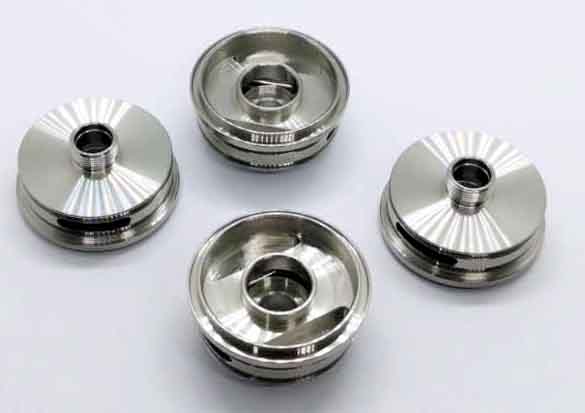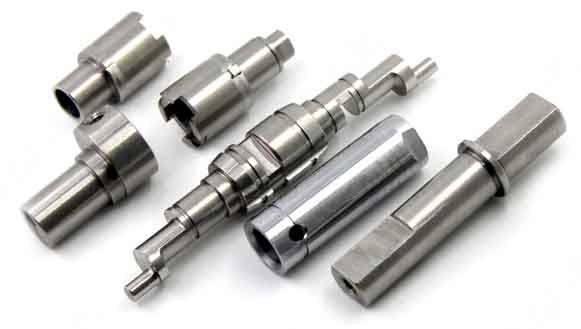本文分析車削淬火鋼的製程設置, 高溫合金, 鈦合金, 冷硬鑄鐵, 及熱噴塗材料零件. 以及這些難切削材料的特點, 切割數量, 車削液, 和車削刀具.
淬火鋼車削技術
1. 變硬的鋼:
①硬化鋼的切割特性:
1) 高硬度: HRC45-70.
2) 高脆弱.
3) 高強度: σb= 2100 ~2600 MPa, 這是關於 4 時代 45 鋼.
4) 大型切割力: 單位切割力KC為4500MPA, 就是 2.5 時代 45 鋼.
5) 高切割溫度: 它的導熱率是 1/7 的 45 鋼.

淬火鋼車削技術
②轉動工具和切割硬化鋼的量:
1) 工具材料: 立方氮化硼, 陶瓷, 硬質合金 (600, 610, 渴望的, YT05, 758, 813), ETC.
2) 工具幾何參數: C0 = 0〜-10°, 工件硬度和連續切割γ0= -10〜-30°, A0 = 8 ~10°, κR= 30〜60°, λs= 0〜-3° .
3) 切割量: 水泥碳化物VC = 30 ~50m/min; 陶瓷工具VC = 60 ~120m/min; PCBN工具VC = 100〜200 m/min, VC是 1/2 間歇性轉彎期間的上述, αp和f是 1/2 一般鋼.
筆記: 一般來說, 淬火鋼的耐熱性為200 ~400℃, 它的硬度隨溫度升高而降低. 工具材料的耐熱性 (硬合金, 陶瓷, 立方氮化硼) 分別為800 ~1000℃, 1200℃, 1400~1500℃, 使用此功能, 連續切割, VC不能太低選擇; 鑽孔時, VC應該是合理的, 該工具應撤回; 在連續切割過程中, F應該很小, κR應適當減少, γε增加, λs應該為負.
超級合金的轉向技術

超級合金的轉向技術
2. 轉向超級合金
因為高溫合金包含許多高熔點合金元素Fe, 的, 鉻, 在, V, w, 莫等. 該元素和其他合金元素形成具有高純度和緻密結構的奧氏體合金. 包含的元素和非金屬元素c, 乙, n, ETC. 形成高硬度的金屬和非金屬化合物, 低比重, 和高熔點. 使其他可加工性非常差. 它相對轉向的可加工性只是 5-20% 的 45 鋼.
①超合金的轉彎特徵:
1) 大型切割力: 2 到 3 比切割一般鋼大的倍.
2) 高切割溫度: 50% 高於切割 45 鋼.
3) 嚴重的工作硬化: 切割表面和加工表面的硬度為 50-100% 高於矩陣.
4) 工具很容易穿: 粘附, 擴散, 氧化, 和凹槽磨損很容易發生.
tosing高溫合金工具的材料:
1) 高速鋼: 含高釩的高速鋼, 應使用高碳和鋁.
2) 水泥碳化物: 應使用YG的細和超細顆粒
③高溫合金轉動工具的幾何參數:
變形超合金: C0 = 10°, 鑄造超級合金: C0 = 0°, 通常不接受負面的倒角. A0 = 10 ~15°, 粗糙轉動λs= -10°, 細扭轉λs= 0 ~3°, κR= 45〜75°.
④扭轉超級合金數量:
1) 高速鋼切刀: VC = 3 ~8m/min.
2) 碳化物工具: VC = 10 ~60 m/min. 變形超合金: VC = 40〜60m/min. 鑄造高溫合金: VC = 7 ~10m/min. αp和f>0.1毫米.
⑤為高溫合金切割液: 與不銹鋼相同.
⑥高溫合金鑽孔: 應盡可能多地使用碳化物鑽或S型和淺孔鑽頭; 例如, 使用高速鋼鑽, 增加的大小 2 電線, 研磨α0和B, VC是 3 M/我, F為0.2 ~0.3mm/r; 鑽頭應該很鋒利, 直鈍的標準是 1/2 到 1/3 一般鋼. 最好使用自動飼料, 不要停在切割表面.

鈦零件車削技術
鈦零件車削技術
3. 鈦合金的轉動:
鈦合金是近幾十年來開發的一種新金屬. 因為它的特異性很高 (SB/P = 1680/4.5 = 373, 4.5 時代 45 鋼), 高熱強度 (長期工作在500℃), 良好的耐腐蝕性, 和出色的低溫性能, 它用於航空航天, 化工 , 醫療, ETC.
①鈦的切割特徵:
1) 鈦的切割溫度很高: 在相同的切割條件下, 它高的高度是切割的兩倍 45 鋼.
2) 鈦具有良好的親和力和認真的聯繫, 這將在高溫下引起粘合.
3) 鈦具有高化學活性: 在高溫切割條件下, 它與O反應, n, H, C在空氣中形成Tio2的硬皮膚層, 錫, tih, ETC。, 這帶來了切割困難.
②轉動鈦的工具材料:
1) 高速鋼: 除了普通的高速鋼, 最好使用高葡萄酒, 高銅, 和含鋁的高速鋼.
2) 水泥碳化物: YG8, YG6X, YG6A, 813, 643, YS27, YD15.3) PCD, PCBN天然鑽石.
③工具幾何參數: C0 = 5 ~15°, α0≥15°.
④轉動鈦的數量:
1) 高速鋼切刀: VC = 8 ~12 m/min.
2) 水泥碳化物工具: VC = 15 ~60 m/min.
3) PCD, PCBN天然鑽石工具: 濕切割VC = 200 m/min
幹切割VC = 100 m/min, AP>0.05毫米, F>0.05毫米/轉.
⑤鈦切割液: 乳液和極端壓力乳液用於一個. 極端壓力切割油用於完成.
⑥註明鈦:
轉動細長的軸 (桿), 現場中心和尼龍應用作工具支架和中心框架的爪子支架; 旋轉時, 使用蓖麻油 60% + 煤油 40% 切割液體; 敲擊時, 適當增加底孔的直徑.
4. 轉彎鑄鐵:
鑄鐵的表面層是白色的, 硬度可能達到HRC60; 單位切割力K C可以到達 3000 百萬帕, 就是 1.5 剪切的時間 45 鋼; 切割力集中在尖端附近, 加工中有毛孔和沙子, 切割時可以輕鬆損壞該工具;
它的脆性很大, 在切割過程中,邊緣碎屑和礦渣的現象將發生.
①用於轉動鑄鐵的工具材料:
1) 水泥碳化物: 應選擇具有高硬度和彎曲強度的膠結碳化物. 例如: ys2, 渴望的, YS10, 600, 610, 726.
2) 陶瓷: SG4, AT6, SM, FT80, FT85.
3) 立方氮化硼: 用於罰款.
②用於轉動鑄鐵的工具的幾何參數: 1) 碳化物: C0 = 0〜-5°, A0 = 5 ~10°, κR≤45°(κR= 45°), λs =-5~一10°, GE = 0.5~1毫米;
③切鑄鐵的量:
1) 碳化物工具: 粗加工VC = 7 ~10m/min, αP= 5 ~10mm, F = 0.5 ~1.5mm/r. 精加工: VC = 15 ~20m/min, αP= 0.5 ~2mm, F = 0.3 ~0.5mm/r.
2) 陶瓷工具: VC = 40 ~50m/min, αP= 0.5 ~2mm, f = 0.3~0.6mm/r.
3) PCBN切刀: VC = 60 ~70m/min, αP= 0.5 ~2mm, F = 0.1 ~0.3mm/r.
5. 熱噴塗的轉動 (焊接) 材料:
熱噴塗材料主要是多組分高強度合金. 高溫並在工件表面噴塗高速後, 硬度, 耐腐蝕性能, 工件表面的耐磨性和耐熱性得到了極大的改善, 它被廣泛使用. 基於銅和鐵的粉末噴塗的硬度更容易切割. 基於鈷和鎳的粉末噴塗的硬度是 >HRC50, 很難切割. 鈷層WC, 穿著鎳的WC, 和粘性的AL2O3噴塗塗料具有硬度> HRC65, 這是最難切割的.
①用於轉動熱噴塗材料的工具材料:
1) 水泥碳化物: 硬度>HRC45, 使用YG, YW膠結碳化物;
硬度, 使用 600, 610, 726, 767, YR05, YC12, ys2, 渴望的;
硬度>HRC65, 使用YG3X, YR05, YC09, YC12, 渴望的, 600, 610.
2) 陶瓷切割器: 3) 立方氮化硼
②轉動熱噴霧材料時工具的幾何參數: C0 = 0〜-5°, A0 = 8 ~12°, κR≤45°.
③切割熱噴塗材料的量: 水泥碳化物VC = 6 ~40m/min;
陶瓷切割器VC = 18 ~80m/min;
PCBN工具: VC = 24〜160m/min. αP= 0.15 ~0.6mm; F = 0.1 ~1mm/r.
 English
English العربية
العربية 中文(漢字)
中文(漢字) Čeština
Čeština Dansk
Dansk Nederlands
Nederlands Suomi
Suomi Français
Français Deutsch
Deutsch Italiano
Italiano 日本語
日本語 ಕನ್ನಡ
ಕನ್ನಡ 한국어
한국어 Português
Português Русский
Русский Slovenčina
Slovenčina Español
Español Svenska
Svenska Türkçe
Türkçe

